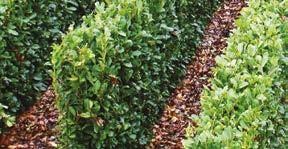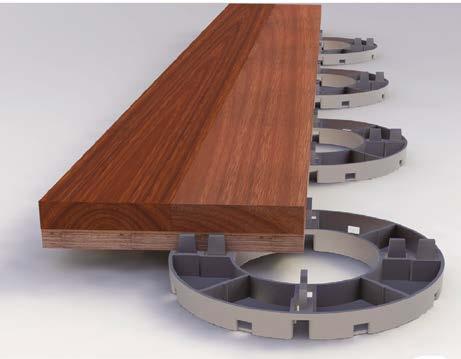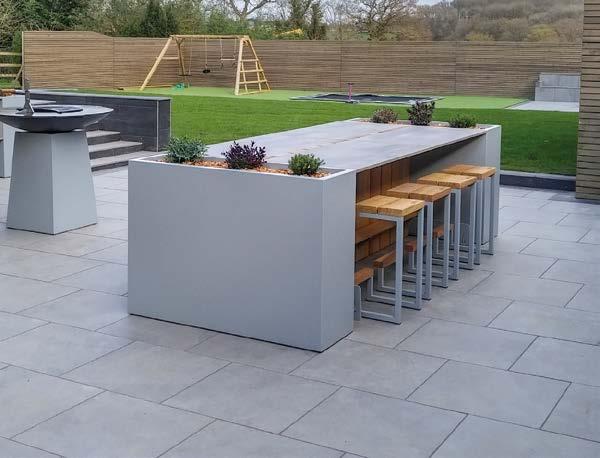
7 minute read
Designing a garden with self

DESIGNING A GARDEN WITH SELF-SUFFICIENCY IN MIND

Having a self-sufficient garden is not a trend, it is a way of life. When designing a garden, the overall aesthetic may be a main factor, but the practicality and overall usage of the space is also of the upmost importance. Creating a garden that is specifically designed with contributing to helping the environment, protecting wildlife and providing a more sustainable way of living is particularly beneficial. Here, various design and instillation options are considered for building a garden with self-sufficiency in mind.
Growing vegetables
Being able to grow vegetables is a huge part of sustainable living and should be one of the main design aspects for consideration within a self-sufficient garden. In order to prepare a space for vegetable growth, it’s important to understand the area and landscaping to hand. Whilst some gardens have an abundance of available space, others have less options, so it’s important to consider the scope of any possible vegetable patch throughout the planning phase. Whilst larger spaces

naturally provide a more fruitful growing experience, “Urban gardens” are certainly on the rise, with various design and logistics options available to those with less land to work with.
If the area is limited, growing vertically is a suitable option. Consider wall-mounted growing or the installation of window boxes; doing this utilises the minimal ground space available, with plants and crops growing in an upwards trajectory.

Gardens that have more space will naturally allow more scope; if crop growth is a core part of a sustainable living journey, a variety of crops will no doubt be sown at the same time. With a larger space, you’re able to position each individual crop within its most favoured position to suit its individual needs, supporting each plants prospering accordingly. Designing a garden with selfsufficiency in mind requires varying levels of tools and equipment. If you’re planning on cultivating crops, you’re going to need somewhere to safely keep your gardening kit, so it’s advisable to plan the addition of a greenhouse or shed within your original designs. The many variations of garden sheds are ideal for accommodating a sustainable space, with metal and concrete sheds for longevity and various wooden sheds for more mindful living.
Incorporate a water butt
Installing a water butt in the garden is an efficient way to reduce water waste. A water butt helps to collect rainwater from the shed or roof which can then be re-used and dispensed around the garden to water crops and plants, avoiding unnecessary water consumption. If the design aesthetic of the selfsufficient garden is also a top priority, water butts aren’t always the prettiest of instillations. That being said, there are some fantastic ways to disguise the equipment; consider blending the butt in with a lick of paint, disguising it as a flower planter or even building a trellis enclosure.
Install a composter
Making your own compost is a fantastic resource for reducing household waste and supporting plant and crop growth within your eco-garden.


Katie Bayliss, Marketing Co-ordinator and specialist in garden sheds from GBC says, “Composting is an important part of any eco-friendly garden, it’s an easy and low-cost means of disposing of household waste whilst simultaneously creating natural nutrients for the surrounding soil. By investing time into composting, you’re able to tend to your garden in a completely self-sufficient way.” A compost heap can be comprised from everything including leaves and paper to coffee and tea, as well as all organic food waste. The resulting compost will leave your plants with healthy, nutrient-rich soil.

When designing a designated space in the garden for the composter, consider it’s positioning. By positioning the composter within an enclosed space that’s close to the house, the home inhabitants will be more likely to successfully utilise the composter on a regular basis.
Potential to extend total food production
Depending on the brief when designing the garden, it may be optimal to leave space where there is the potential to extend the produce that is produced. For example, saving space for a chicken pen to be built would allow for chickens to be kept for eggs and organic meat. The inclusion of a beehive is also a popular sustainable option; keeping bees and attracting butterflies will help to pollinate the garden’s crops, as well as producing honey in the appropriate seasons. The space could even be used to grow fruit trees – all things are worth considering if possible. Developing a sustainable garden doesn’t have to be complex and the long-term benefits that a self-sufficient garden creates are endless. By implementing a range of design elements that support selfsufficiency, avid gardeners and new members alike will be able to do their bit in helping the environment.
UK grown instant hedges, mature trees & expert planting service








Supply
Plant




Maintain




For more details on the original, UK grown, instant hedges please contact us for expert advice and the best prices guaranteed.
www.treeandhedge.com 01895 438 811
THE PERFECT SOLUTION FOR YOUR NEXT DECKING OR PAVING PROJECT

FROM EURO ACCESSORIES
Fast and easy to use in all weathers. Adjustable for all sites and slopes. Allows easy access to utilities concealed below the deck. Continuous drainage through joint spacers means no accumulation of water on decks or paving. It provides a point-to-point intervention in insulation problems. It has a high load resistance (Min 900kg/pc) Provides the final level without any screed concrete on installation.
Karoapp fixed and adjustable pedestals for use on decking and paving are the latest brand to reach the UK market and are available from Euro Accessories Ltd.
Fixed pedestals are available in 4 different heights ranging from 13mm to 30mm. Adjustable pedestals are available in 6 different adjustable heights ranging from 18mm to 225mm. By incorporating the extension piece a further 7 adjustable heights are available, offering a complete range from 18mm up to a staggering 1083mm.
Karoapp pedestals are fully tested and offer a minimum load resistance of 900kg each. Using recycled plastics, they help prevent moisture to the deck / patio helping to increase its life.
Euro Accessories professional pedestal team can also offer assistance with any development or project you have.
For more information on Karoapp Tel. 01189 81 95 22 www.karoapp-pedestals.co.uk | sales@euroacc.co.uk

For more information on Karoapp Tel. 01189 81 95 22 www.karoapp-pedestals.co.uk | sales@euroacc.co.uk
CENTURION CLUB. SEE CASE STUDY ON GRILLO.UK.COM/PROJECTSCENTURION CLUB. SEE CASE STUDY ON GRILLO.UK.COM/PROJECTS



2020 has seen the UK’s thriving outdoor living 2020 has seen the UK’s thriving outdoor living scene grow exponentially. scene grow exponentially.
Outdoor kitchens present a unique opportunity Outdoor kitchens present a unique opportunity for clubs and event venues. Customers are for clubs and event venues. Customers are buying experiences; get the experience right, and buying experiences; get the experience right, and they’ll come back time and again. Add a unique they’ll come back time and again. Add a unique idea to your next project.idea to your next project.
Design resources Design resources
We’re geared to work with landscape We’re geared to work with landscape professionals. Detailed CAD downloads and professionals. Detailed CAD downloads and moodboard images are available online, and a moodboard images are available online, and a wide variety of example layouts with pricing and wide variety of example layouts with pricing and datasheets makes specifying straightforward.datasheets makes specifying straightforward.










